Mahale Mountains National Park (Part 1 of 3)
 Monday, May 10, 2010 at 01:07PM
Monday, May 10, 2010 at 01:07PM Back in October of 2009, I led a safari to the remote region of Tanzania where the mountains meet the sea, where wild chimpanzees rule the jungle, and also where one company has managed to pull of an extraordinary experience for their guests. If you are interested in a very unique safari experience, read on. If you appreciate other peoples' wanderlust to locate remote places on the planet and come home with rich photographs and memories, you should also read on.
Background
I normally lead my photographic safaris to locations which are rich in mammals and birds, and these locations are almost always accessed with Land Rovers twice each day: a morning game drive and an afternoon game drive. The safari which I am about to describe began in this manner out on the open savannah of the Serengeti National Park, and after 6 days of that style of safari we traded in our diesel vehicles for other modes of transportation: long bush plane flights, boats on Lake Tanganyika and hiking with our feet.
Our destination was Mahale Mountains National Park, which lies on the eastern shore of Lake Tanganyika, Tanzania. Lake Tanganyika is estimated to be the second largest fresh water source on the planet, second only to Lake Baikal. The lake also borders the Democratic Republic of Congo, Burundi and Zambia. Mahale Mountains N.P. (now referred to just as Mahale in this blog entry) is a large sanctuary for wild chimpanzees, as well as many other animals and birds. Mahale is extremely remote and difficult to get to, and required us to fly on a private chartered Cessna Grand Caravan across Tanzania for half a day. We landed along the shore of Lake Tanganyika, and we were picked up by the staff of the camp where we were to stay for the next 3 nights, Greystoke Mahale.
Our boat was large and comfortable, and the camp staff greeted us with big smiles, cold drinks and a wonderful lunch. The boat ride took us from our airplane to our camp, about a 2 hour journey. The scene was very dramatic, as the mountains met the deep lake with only a small sliver of beach in the middle. As we enjoyed our cold beer, vagetable samosas and sandwiches, we imagined just how many wild chimpanzees were in the forest just off the lake's edge. Researches have some idea, however there is no easy way of doing a census due to the difficult terrain of the area.
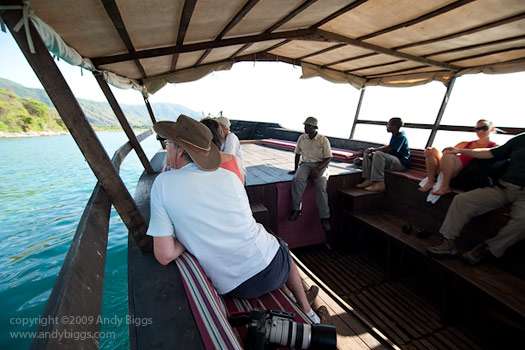
Our dhow for the next 3 days
After our relaxing 2-hour journey on the boat, we turned around a bend and all of a sudden we saw our luxurious camp out on the beach. It was like Robinson Crusoe meets civilization. Well, sort of. My idea of luxurious is likely very different than that of those who will only stay at a Ritz Carlton property, but this place was fantastic. I have a habit of taking over camps completely, and this is what we did with the Greystoke Mahale camp. We had full run of the place, and I am glad that we arranged it this way. The camp is set right on the lake's edge, and the main building is where all meals are served. All individual huts where we slept were slightly out of sight from the water, and were very very comfortable by any standards.
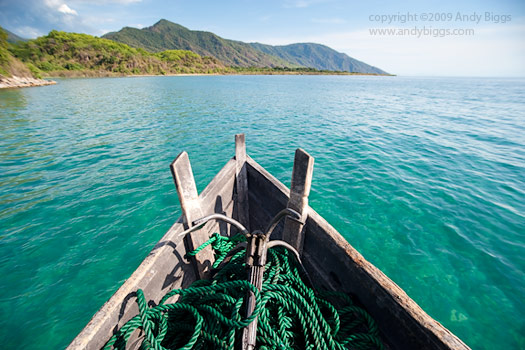

Greystoke Mahale, along the shores of Lake Tanganyika

The dining hut, Greystoke Mahale
After our arrival on the beach, we were greeted by the camp staff who helped us off of the dhow. Grins from ear to ear, my guests settled into their huts for a quick afternoon nap. Some took a short hike in the forest, and others relaxed to watch the sun get low in the sky. The camp is on a small piece of land that happens to be level. Everything behind the camp is a steep and thick forested mountain. You can see the following image to fully appreciate what a hike in the mountains means. We would soon learn what that meant.
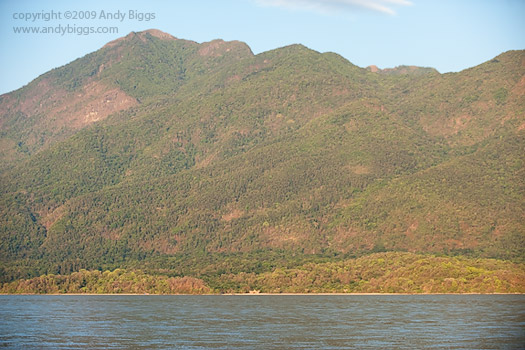
Mahale Mountains from Lake Tanganyika.
(notice Greystoke Mahale camp at the water's edge)
As the sun set we all gathered for drinks at the bar, and we talked about the long journey to get there. I thought about that one for a minute: If I left my home in the USA it would have taken me about 40 hours to reach there: car, plane, plane, car, car, bush plane, refuel, bush plane, dhow. The camp manager said that the closest road to us was easily 50 to 100 miles away, and I could certainly believe it.
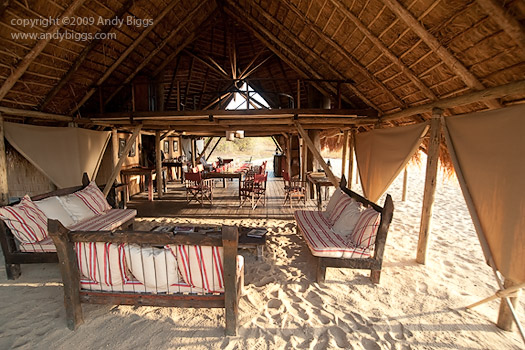
The common area of Greystoke Mahale
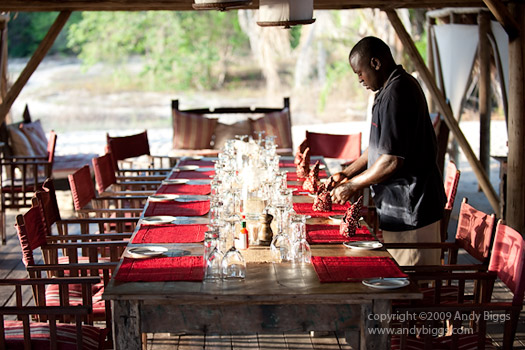
Getting ready for a meal in the dining hut
As we sipped our drinks, the sun set behind the mountains in the Democrative Republic of Congo in the distance. I thought to myself "why haven't I made it here before now". I didn't have an answer for that one, as I had always imagined photographing wild chimpanzees, but I never got around to planning the trip. I was looking forward to 3 nights at Greystoke, and was especially looking forward to photographing wild chimpanzees in their own environment.
 Chimpanzee,
Chimpanzee,  Greystoke,
Greystoke,  Mahale,
Mahale,  Tanganyika,
Tanganyika,  safari in
safari in  Safaris
Safaris 


Reader Comments (1)
Looking forward to the next installment. Sounds like a fun adventure!!!